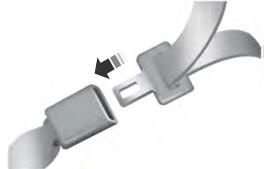Ford Explorer: Adaptive Cruise Control / Switching Adaptive Cruise Control On and Off
Ford Explorer 2020-2025 Owners Manual / Adaptive Cruise Control / Switching Adaptive Cruise Control On and Off
The cruise controls are on the steering wheel. See Cruise Control.
Switching Adaptive Cruise Control On
 Press to set the system in standby
mode.
Press to set the system in standby
mode.
The indicator, current gap setting and set speed appear in the information display.
Switching Adaptive Cruise Control Off
 Press when the system is in standby
mode, or switch the ignition off.
Press when the system is in standby
mode, or switch the ignition off.
Note: You erase the set speed and gap setting when you switch the system off.
Automatic Cancellation or Deactivation
The system may cancel if:
- The tires lose traction.
- You apply the parking brake.
The system may cancel and set the parking brake if:
- You unbuckle the seatbelt and open the driver door after you stop your vehicle.
- Your vehicle is held at a stop continuously for more than three minutes.
The system may deactivate or prevent activating when requested if:
- A sensor is blocked.
- The brake temperature is too high.
- There is a failure in the system or a related system.
 Adaptive Cruise Control Limitations - Vehicles With: Adaptive Cruise Control
With Stop and Go
Adaptive Cruise Control Limitations - Vehicles With: Adaptive Cruise Control
With Stop and Go
Sensor Limitations
WARNING: On rare occasions, detection issues can occur due to the road
infrastructures, for example bridges, tunnels and safety barriers...
 Setting the Adaptive Cruise Control Speed
Setting the Adaptive Cruise Control Speed
Drive to the speed you prefer.
Press the toggle button upward or downward
to set the current speed.
Take your foot off the accelerator pedal.
The indicator, current gap setting and set speed a..
Other information:
Ford Explorer 2020-2025 Service Manual: Removal and Installation - Rear Heater Core Inlet Line
Removal NOTE: The rear heater core inlet line is installed from the factory as a one-piece assembly. The replacement part is supplied as an assembly, containing the rear heater core outlet line and the rear evaporator inlet and outlet lines. Remove the rear evaporator rear outlet and inlet line...
Ford Explorer 2020-2025 Service Manual: Removal and Installation - Intermediate Speed Sensor B (ISSB)
Removal Remove the main control valve body. Refer to: Main Control Valve Body (307-01B Automatic Transmission - 10-Speed Automatic Transmission – 10R80, Removal and Installation). Remove the intermediate speed sensor B. Slide the plastic lock to the unlocked position...
Categories
- Manuals Home
- 6th Generation Explorer Owners Manual
- 6th Generation Explorer Service Manual
- Description and Operation - Jacking and Lifting - Overview
- Using Tether Straps
- Electric Parking Brake
- New on site
- Most important about car
Fastening the Seatbelts
The front outboard and rear safety restraints in the vehicle are combination lap and shoulder belts.

Copyright © 2025 www.foexplorer.com
